If you want to add some spice to your life, look no further than the chilli pepper. Chillies come in various shapes, sizes, and colours, ranging in heat from mild to fire-alarm hot.
But no matter your heat preference, there’s a chilli out there for you.
Check out this list of eleven different chilli varieties to find the perfect one for your next meal.
Eleven Popular Chilli Varieties
There are around 4,000 varieties of chillis worldwide, so we’ve only picked our favourites and the most commonly used chilli peppers.
How Is Chilli Heat Measured?
The chilli pepper’s heat is measured in units called the Scoville Heat Unit (SHU).
The Scoville heat unit measures the capsaicinoid concentration of chilli pepper. Capsaicinoids are the compounds responsible for the “heat” in chilli peppers. The higher the capsaicinoid concentration, the higher the SHU rating.
SHUs are measured on a scale from 0-16,000,000. For reference, bell peppers have a rating of 0 SHUs, while habanero peppers have a rating of 350,000 SHUS.
With each chilli pepper listed below, we have included the SHU.
Jalapeño Peppers
SHU: 2,500 – 8,000
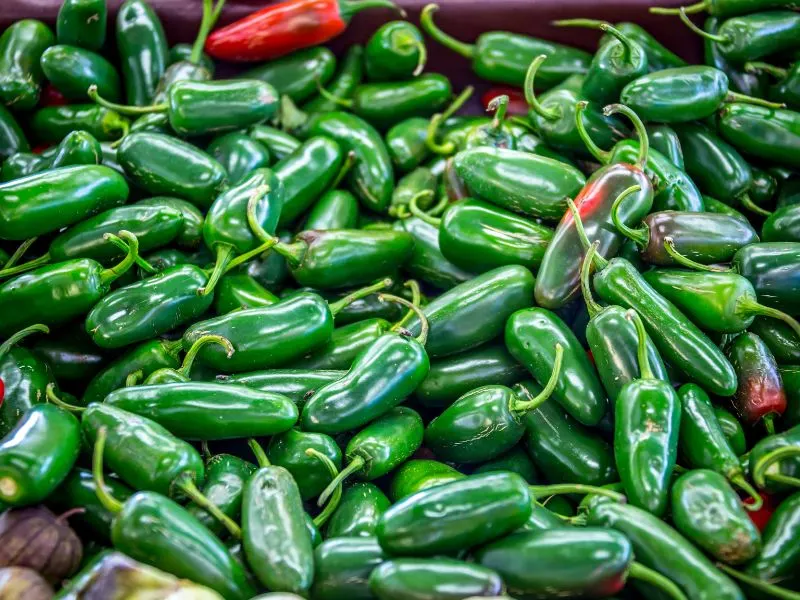
If you’re looking for milder chilli pepper, jalapeños are a good option. They can be used in various dishes, from nachos to omelettes. Jalapeño peppers are usually green when immature and red when they’re ripe. You can also find jalapeño peppers that have been smoked, which gives them a deeper flavour.
Chipotle Peppers
SHU: 5,000 – 10,000
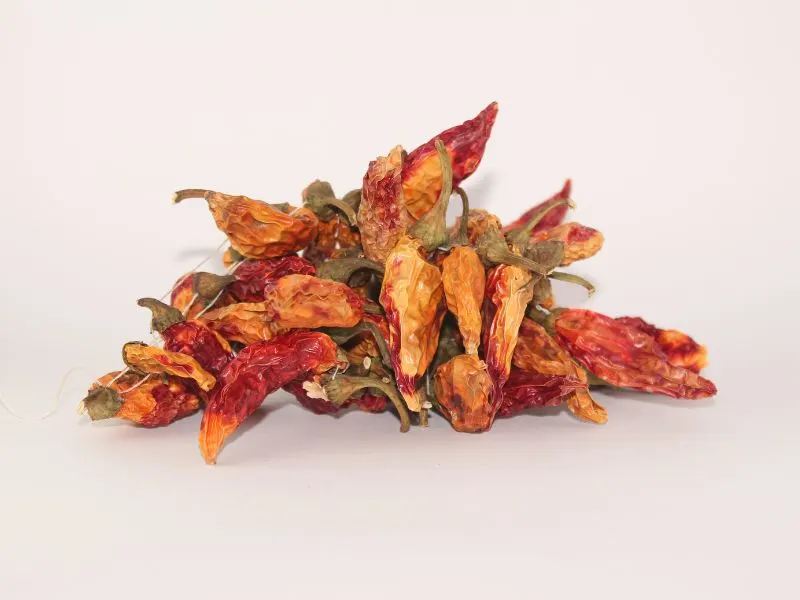
Chipotle peppers are actually smoked jalapeño peppers that have been dried and then canned in adobo sauce. They have a deep, smoky flavour that pairs well with grilled meats, rice, and beans.
You can usually find chipotle peppers canned or jarred at your local supermarket as well as chipotle paste.
Chipotle peppers feature in many Mexican Recipes such as Chicken Fajitas, Mixed Bean Chilli and Beef Burritos.
Related: What Is Chipotle Paste?
Poblano Peppers
SHU: 1,000 – 2,000
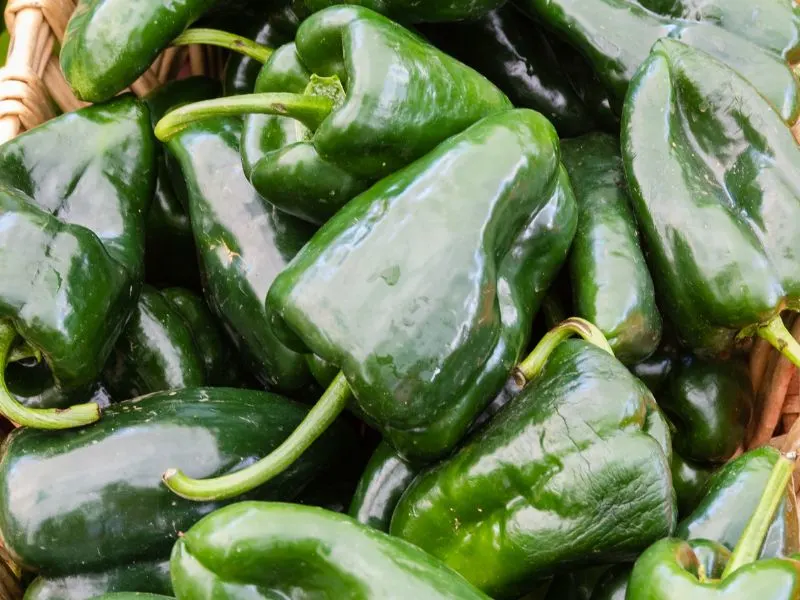
Poblano peppers are another good option for those who don’t like their food too spicy. Poblano peppers are commonly used in dishes like chilli con carne and enchiladas. They’re usually dark green or brown and have a wrinkled appearance. When dried, poblano peppers are known as ancho peppers.
Serrano Peppers
SHU: 10,000 – 25,000
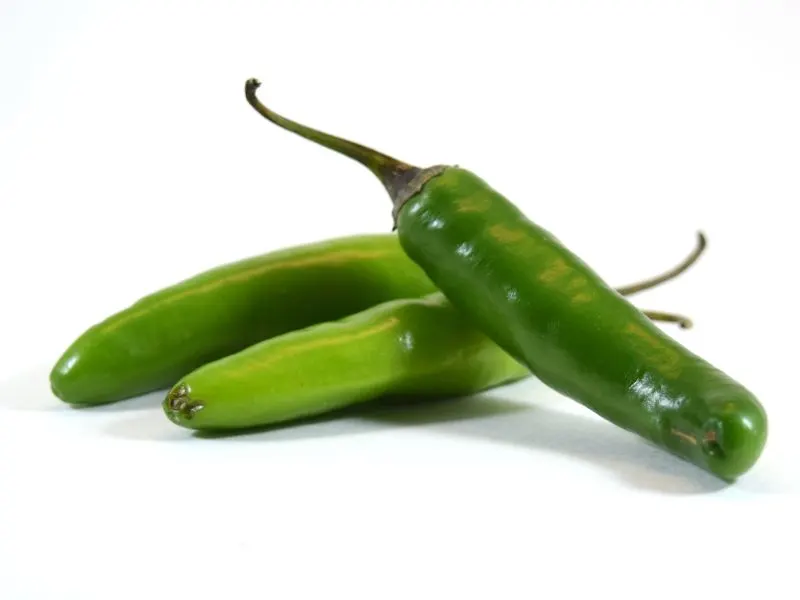
Serrano peppers are similar in appearance to jalapeños, but they pack more of a punch when it comes to heat. They’re often used in salsas and sauces because of their intense flavour. Serrano peppers are usually bright green but can also be found in shades of orange or red when they’re ripe.
Habanero Peppers
SHU: 100,000–350,000
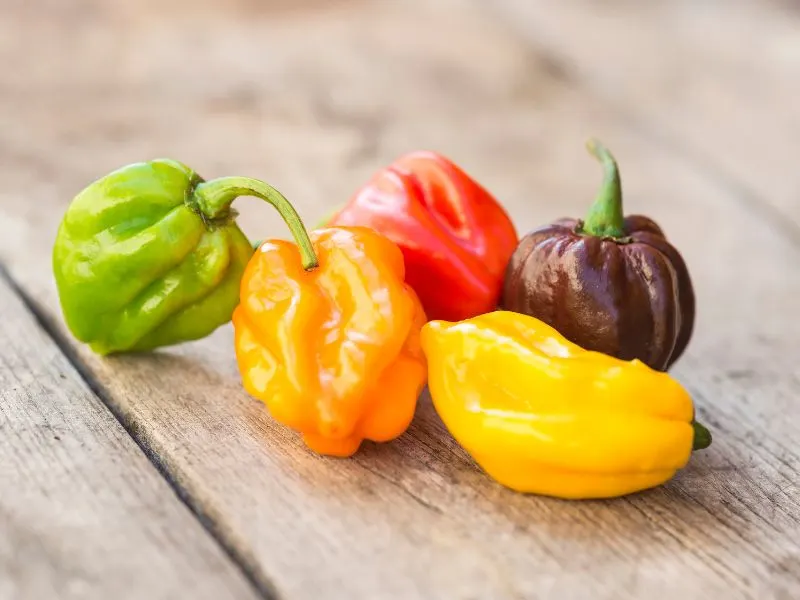
Most Habanero peppers are hot—so beware if you’re not a fan of spicy food! Habanero chilli peppers are often used in Caribbean cuisine and can be found fresh, dried, or pickled. They typically range in colour from green to orange to red and often have a floral aroma.
Scotch Bonnet Peppers
SHU: 125,000 – 325,000
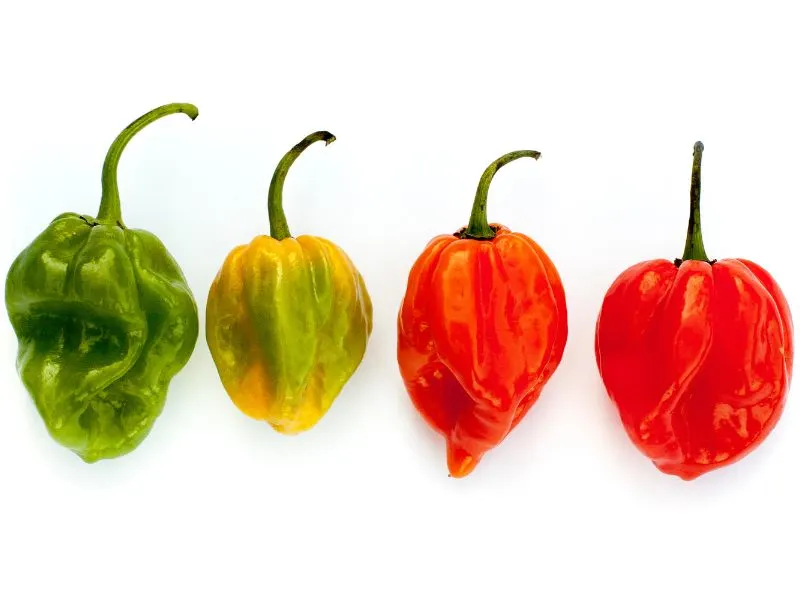
Scotch bonnet chilli peppers are similar to habanero chilli peppers—they’re small but pack a big punch when it comes to heat! Scotch bonnet peppers are commonly used in Jamaican cuisine and get their name from their resemblance to a type of tam o’ shanter hat worn by Scottish men centuries ago.
These chilli peppers range in colour from yellow to orange to red and can even be found with stripes or spot patterns.
Cayenne Peppers
SHU: 30,000 – 125,000
Cayenne peppers are often used in powder form as a seasoning or in whole form as an ingredient.
Cayenne peppers measure between 30,000 and 125,000 on the Scoville heat scale, making them one of the hotter chilli peppers.
Cayenne peppers are usually red or green when mature but can also be yellow, orange, or brown
Bird’s Eye Peppers (Thai Chillies)
SHU: 100,000 – 225,000
Bird’s eye chilli peppers get their name from their small size and round shape—they resemble bird’s eyes!
As the name suggests, Thai peppers originate from Thailand—but you can find them in Asian supermarkets and online.
Thai chilli peppers are very hot—not for the faint of heart! They’re often used in curries or other dishes that require a lot of heat to balance out the sweetness of the other ingredients (like coconut milk).
Bird’s eye chilli peppers measure up at 100,000 to 225,000 on the Scoville heat scale, making them one of the hottest types of chilli peppers.
These chilli peppers are usually red or green when mature but can also be yellow, orange, or brown.
Padron Peppers
SHU: 500 – 2,500
Padron peppers are common in Spanish foods. The peppers are usually about two inches long and have a slightly sweet flavour. They are often served as tapas or appetisers and are typically served roasted or fried.
Padron peppers range in heat from mild to medium-hot, with most being on the milder end of the spectrum. However, it is important to note that there is some variability in the heat levels of these peppers; about one in every ten Padron peppers is quite spicy. As a result, many people who are eating Padron peppers for the first time will want to exercise caution and try a small piece of pepper before consuming more.
Padron peppers are originally from the municipality of Padrón in the province of A Coruña, in the northwestern Spanish region of Galicia. Today, Padron peppers are widely grown throughout Spain and Portugal.
Padron peppers can be cooked in various ways, commonly fried or roasted, until the peppers have blistering skin.
Ghost Peppers
SHU: 600,000 – 1,041,427
Ghost peppers are one of the hottest chilli peppers in existence! Ghost peppers measure up at over 1 million on the Scoville heat scale (for reference, jalapeños only measure up at around 5,000).
Ghost chilli peppers are so hot that they’re sometimes used as an ingredient in pepper spray!
These chilli peppers get their name from their ability to “ghost” you long after you’ve eaten them—you’ll feel the heat long after these babies have left your mouth!
Ghost chilli peppers are usually red or orange when mature but can also be white or brown.
Carolina Reapers
SHU: 1,500,000 – 2,200,000
Just when you thought it couldn’t get any hotter than a Ghost chilli pepper, Carolina Reapers are even hotter.
They are native to the United States and measure in at an average of 1.64 million Scoville heat units on the Scoville scale. That’s over 400 times hotter than a jalapeño pepper!
If you’re wondering what that feels like, it’s been described as a burning sensation that starts at the back of your throat and spreads through your entire body. Some people have even said that it feels like your head will explode; needless to say, you should be very careful when cooking with Carolina Reapers. Make sure to wear gloves and avoid touching your face while you’re handling them.
Carolina Reapers were originally grown in South America, but they are now cultivated in many parts of the world, including the United States, Mexico, India, and China.
In the United States, they are most commonly grown in North Carolina, hence their name.
Carolina Reapers can be used in both sweet and savoury dishes.
Start by chopping off the stem and then cutting them into small pieces before adding them to your dish. A little goes a long way when it comes to these peppers, so make sure not to add too much.
What Is The Hottest Chilli In The World?
The hottest chilli in the world is the Carolina Reaper. It was recognised as the hottest chilli pepper by The Guiness World Records in 2019. The Caroline Reaper measures an average of 1,641,183 Scoville Heat Units (SHU).
Where To Buy Fresh Chillies
All the main supermarkets stock fresh chillies, and their available varieties will vary. If you are looking for a specific type of chilli, you may want to order directly from an independent chilli grower; try South Devon Chilli Farm or One Stop Chilli Shop.
Growing Chillies
Growing chillies is actually quite easy – even in the UK! Here are a few tips to get you started:
- Start with a good quality chilli pepper seed. This will make all the difference in getting strong, healthy plants.
- Sow your chilli pepper seeds in small pots or trays using a good-quality potting mix. Water well and place in a warm, sunny position.
- Once your chilli pepper seedlings have germinated, transplant them into larger pots or into your garden bed. Water regularly and feed with a high potassium fertilizer to encourage fruiting.
- Be patient! Chilli peppers can take up to 3 months to mature and produce fruit. But the wait will be worth it when you can enjoy your very own homegrown chillies.
Read More: How To Grow Chillies
How To Cook With Chillies
Not all chillies are created equal and can vary widely in terms of heat. If you’re not sure how spicy a particular type of chilli is, it’s always best to err on the side of caution and start with less than you think you need. You can always add more later if you want to!
Handle the chillies with great care, using gloves if possible, and avoid touching your face or eyes while you’re working with them.
When cooking with fresh chillies, remove the seeds and ribs (the white parts of the chilli where the seeds are attached), as these are usually the spiciest parts. You can do this by cutting the chillies in half lengthwise and then scraping out the seeds with a spoon.
If you want to add some heat to a dish but don’t want it to be too spicy, try cooking the chillies whole and removing them before serving. This will allow their flavour to infuse into the dish without making it too hot.
Chilli Recipes
Storing Chillies
Chillies can be stored in the fridge or freezer, or if you want to keep them even longer, they can be preserved or dried.
In the fridge: place them in a plastic bag or container with holes so they can breathe; depending on when and where they were picked, they should last 2-3 weeks.
In the freezer: chillies can be frozen whole or sliced. Chillies will typically last for six months in the freezer, but they might start to lose their flavour after four months.
Preserving: if you want to preserve your chillies for even longer, you can pickle them or make hot sauce. Pickled chillies will last for several months in the fridge, and hot sauce will last indefinitely if stored in a cool, dark cupboard.
Drying: Drying is another great way to preserve chillies. You can hang them up to dry or use a dehydrator. Once they’re dried, they’ll last for 6-12 months if stored in an airtight container in a cool, dark place.
Related: How To Dry Chillies
Final Thoughts
No matter your spice preference, there’s a chilli pepper out there for you. So next time you want to add some flavour (and heat!) to your meal, consider trying one of these different varieties of chilli pepper.
Do you have a favourite type of chilli?
